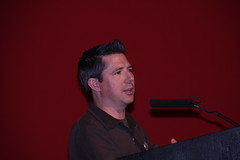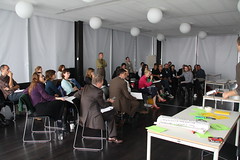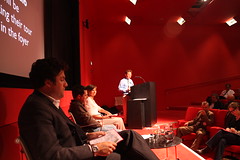Two Recent Recordings
Saturday, July 25th, 2009
I owe a lot to Nancy Proctor, the Head of New Media Initiatives at the Smithsonian American Art Museum. She can safely be labeled a guru of mobile museum tours because her knowledge of the subject matter is extensive. She has also been a great advocate for the work that I have been doing at the San Jose Museum of Art by inviting me to speak at conferences like the Tate Handheld Conference in September 2008.
Recently, I was honored to be involved with two side projects of Nancy’s.
On June 3rd, 2009 I was part of an online conference through Learning Times (sponsored by the American Association of Museums) and organized by Nancy. The conference was focused on handheld tours and built on the collective knowledge of the previous Tate conference. For my part I was involved again with the getting it done section. My presentation titled, “The Little Engine That Could: Mobile Tours on a Shoestring Budget” was paired with that of Silvia Fillipini Fantoni from the British Museum which provided a good contrast of what goes into developing a large mobile tour versus a smaller scale one.
The outstanding list of presenters that day also included – Nancy Proctor herself, Koven Smith from the Metropolitan Museum of Art, Titus Bicknell from Experius/Gateway Auto Museum and Bruce Wyman from the Denver Museum of Art. Nancy and Koven’s part talked about the future of mobile and Titus and Bruce spoke about the rapid development of a mobile tour.
Here are the slides from my presentation:
This was my first online experience and I have to admit I had some concerns going in, but overall I thought that it was very effective. The one bit of strangeness that was prevalent, and expressed by Bruce during his presentation, was that you are speaking into the phone with no gauge on how people are reacting on the other end. A large part of speaking at a conference is gauging the expression on peoples faces as you are talking and making adjustments as necessary to make it more entertaining or more informational. There is obviously no way to do this via an online conference.
My part of the conference is available in it’s entirety and you are more than welcome to listen to all the other sections of too.
The other side project that I was a part of is on her wiki called Museum Mobile where she features regular podcasts around the subject of mobile tours. She had asked me at the 2009 Museums and the Web conference if I would like to be interviewed and I was quick to say yes.
For the interview, which also took place in June, she paired me for a discussion with Ted Forbes from the Dallas Museum of Art who has recently been developing a tour for his museum. In the podcast Nancy asks us a variety of questions about the development of our tours, web app vs. SDK, implementation in the galleries and a host of other juicy tidbits. The conversation was over an hour long and very enjoyable.
You can listen to it on Museum Mobile – Chris & Ted’s Excellent iPod Tours or listen to it here.









